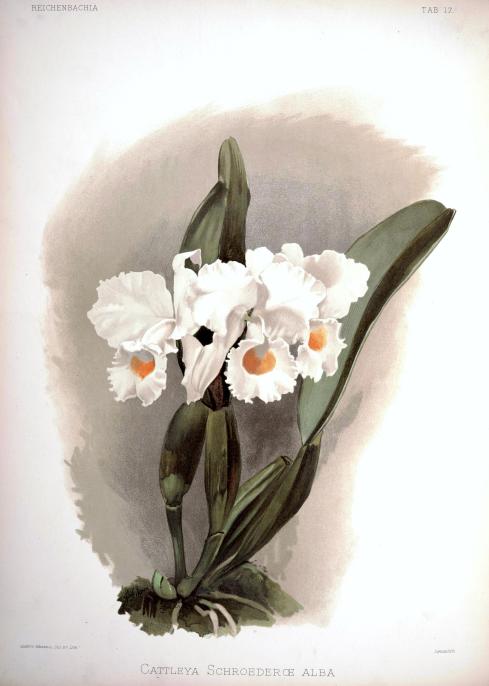The Gardeners’ Chronicle ser. 3. vol. 1: 512 (1887)

Notable varieties:
Its bright, delicious fragrance was distinctive and different from the subtle fragrance of C. trianaei. Its petals and lip were more frilly or crisped, and it was a more vigorous grower. It also produced more flowers on a stem than C. trianaei. C. schroederae has always been considered a feminine flower. Its lovely pale lavender color is often described as ‘overlaid with pink pearl’ has a tantalizingly sweet fragrance. C. schroederae lacked the wide range of color found in C. trianaei, and yet it competed with C. trianaei for the late-February to early-March flower sales. C. schroederae produced three to five flowers on a spike, unlike C. trianaei, which had only two or three. C. schroederae can have seven flowers on a spike if exceptionally well-grown, and can produce a magnificent specimen. One such plant was even pictured in June 1903’s The Orchid Review and the March 1953 American Orchid Society Bulletin. Cattleya schroederae’s excellent shape garnered it nine FCCs from the Royal Horticultural Society in the first 20 years following its discovery. Two of the finest and eventually most famous clones of C. schroederae on the mountain slopes above the Casanare River collected by John Lager:
- C. schroederae f. alba ‘Hercules’ AM/RHS (1925), AM/AOS (1932) – was a beautiful, round, alba form with an orange throat, and striated lateral sepals. It was so fine that Lager used its picture to adorn the stationery of his own orchid company, Lager & Hurrell in Summit, New Jersey. The flower was also pictured in the September issue of the first volume of the AOS Bulletin in 1932.
- C. schroederae ‘Summitensis’ / ‘The Baron’ FCC/RHS (1908) – this was a large blush flower with an intense reddish-orange throat and purple lip. ‘Summitensis’ had a fine round shape and was also sold to a private collector. It was was later acquired by Major George L. Holford (Sir George Holford of Westonbirt fame) who exhibited it under the name ‘The Baron’
More of notable clones of C. schroederae:
- C. schroederae ‘Pitt’s Variety’ FCC/RHS (1901) – did have sepals and petals of a medium lilac color, one of the darkest clone of C. schroederae
- C. schroederae ‘Severn’s’ – modern day dark clone of C. schroederae that approaches the dark coloring of ‘Pitt’s Variety’
- C. schroederae ‘The Prince’ AM/RHS (1910) – very dark lavender form of the species with wide-open lip
- C. schroederae ‘Alexandra James’ AM/RHS (1909) – very wide-open lip
- C. schroederae f. alba ‘Madame Louis de Hemptine’ FCC/RHS (1905) – alba form with sepals that curl backward
- C. schroederae f. alba ‘Mrs. F. Sander’ FCC/RHS (1909) – alba form with overall nice compostition
- C. schroederae ‘Fowler’ AM/RHS (1904) – overall pastel coloring with very impressive golden egg yolk-pink lip and striated lateral sepals
- C. schroederae ‘Glebelands’ FCC/RHS (1912) – overall white form with sepals that curl backwards with rich pink and golden wide-open lip
- C. schroederae ‘Harefield Hall’ AM/RHS (1898) – overall pastel form, wide-spread petals with purple lip
- C. schroederae ‘Queen Alexandra’ AM/RHS (1908) – overall pastel form with golden lip and nice composition
- C. schroederae ‘Robin’ FCC/RHS (1905) – overall pastel form with dark lavender lip almost coerulea
- C. schroederae ‘Heatonensis’ FCC/RHS (1901) – concolor form, very pleasant overall compostition
- C. schroederae ‘Irene’ FCC/RHS (1909) – concolor form with wide-open lip
Notable Primaries:
- Laeliocattleya Elinor AM/RHS (1908) (C. schroederae x L. Coronet) – which retained most of the brilliant reddish-yellow and bronze shades of L. Coronet (cinnabarina x harpophylla) while producing an acceptably shaped flower